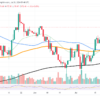
Ripple CTO David Schwartz It recently revealed updates on its trading robot, which sparked intrigue within the XRP community. The bot, developed by Schwartz, operates with an algorithm reminiscent of the XRP Ledger’s AMM algorithm. Schwartz, initially designed to trade on centralized exchanges, revealed that the bot has undergone testing, focusing primarily on Solana.
Ripple CTO David Schwartz It recently revealed updates on its trading robot, which sparked intrigue within the XRP community. The bot, developed by Schwartz, operates with an algorithm reminiscent of the XRP Ledger’s AMM algorithm. Schwartz, initially designed to trade on centralized exchanges, revealed that the bot has undergone testing, focusing primarily on Solana.
In a recent development, Schwartz revealed the implementation of a new strategy for the bot, envisioning three distinct AMMs for Ethereum, Bitcoin, and Solana. This adjustment, he explains, allows for a more aggressive approach, allowing the robot to take on additional risks while expanding trading opportunities. Based on previous estimates, Schwartz expressed optimism about the bot’s profitability, estimating an annual return of approximately 11%.
Importantly, Schwartz clarified that AMMs are not exclusive to XRP, as they can be created with any two assets backed by the XRP Ledger. However, he predicted that AMMs involving XRP will likely dominate, attributing this to the algorithm’s bias towards volatility harvesting, particularly advantageous in volatile markets.
Meanwhile, controversy surrounds the XRPL AMM, the foundation on which Schwartz’s robot is built. RippleX, the development arm of Ripple, has identified discrepancies in certain AMM pools, resulting in transaction execution issues.
As a precautionary measure, RippleX has advised against depositing new funds into these pools until the discrepancies are rectified. According to the report, the engineering team is working together with community participants to address the issue, promising timely updates to the community.























